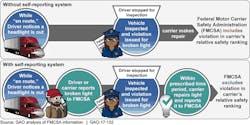The U.S. Government Accountability Office (GAO) concluded a report to congressional committees on motor carriers and the feasibility of establishing a system for self-reporting equipment problems. The report found self-reporting to be feasible, but safety benefits are questionable and costs are unknown.
What GAO Found
Establishing a system that would provide incentives for trucking companies to self-report equipment problems may not necessarily yield safety benefits.
Most stakeholders GAO interviewed—including selected carriers and drivers—thought a self-reporting system would be unlikely to produce safety benefits, stating that it would not incentivize quicker repairs. If repairs are not made more quickly, there would be no positive impact on safety. Three drivers, however, thought a self-reporting system could yield some safety benefits if it incentivized drivers to do more thorough inspections of their vehicles.
Officials from industry groups and the Federal Motor Carrier Safety Administration (FMCSA) noted that a self-reporting system could negatively impact safety, such as by encouraging distracted driving if drivers report equipment problems on their cell phones while driving. Moreover, estimating the potential safety impacts of such a system requires information that is not currently available, such as how equipment problems that would be permitted to be self-reported are related to crashes.
FMCSA has the statutory and regulatory authority to establish a system for self-reporting equipment problems, and technology exists to create it, but its costs are unknown. Also, establishing such a system could pose challenges for FMCSA, carriers, and drivers. For example, developing a new system could delay efforts FMCSA has under way to improve its information technology, and carriers or drivers may have difficulty selecting their specific equipment problem from the more than 300 potential vehicle maintenance violations. Further, without information on key design features of a self-reporting system, such as whether reporting would be through a telephone hotline or a web-application, it is not possible to estimate costs with any reasonable degree of confidence. FMCSA developed a rough estimate that a self-reporting system would cost between $5 and $10 million to establish and operate for the first year.
Why GAO Did This Study
In 2015, more than 4,000 people were killed in crashes involving large trucks. To identify carriers with the highest crash risk, FMCSA uses information from roadside inspections and crashes to rank each carrier's safety performance relative to other carriers in seven categories, including one on vehicle maintenance. Some stakeholders have proposed a system for carriers or their drivers to self-report en route vehicle equipment problems to FMCSA. Reported equipment problems that were repaired within a certain time period would not affect the carrier's relative ranking, potentially incentivizing carriers to make repairs more quickly.
The Fixing America's Surface Transportation Act included a provision for GAO to examine the cost and feasibility of establishing a system for carriers or drivers to self-report vehicle equipment problems to FMCSA. This report examines (1) the potential safety impacts of a self-reporting system and (2) factors that could affect its feasibility and cost.
GAO reviewed relevant regulations, information on other existing DOT self-reporting systems, and prior related GAO work. GAO also interviewed a non-generalizable sample of representatives from six industry and safety associations, six carriers, and six drivers about this potential system for self-reporting equipment problems. GAO selected carriers to include those with diverse fleet sizes and average distances traveled, and drivers from six additional carriers.
DOT provided technical comments, which were incorporated as appropriate.


